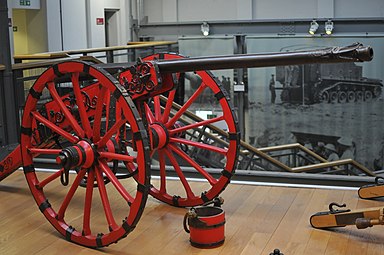A cannon is a large-caliber gun classified as a type of artillery, which usually launches a projectile using explosive chemical propellant. Gunpowder was the primary propellant before the invention of smokeless powder during the late 19th century. Cannons vary in gauge, effective range, mobility, rate of fire, angle of fire and firepower; different forms of cannon combine and balance these attributes in varying degrees, depending on their intended use on the battlefield. A cannon is a type of heavy artillery weapon.
A muzzleloader is any firearm in which the user loads the projectile and the propellant charge into the muzzle end of the gun. This is distinct from the modern designs of breech-loading firearms, in which user loads the ammunition into the breech end of the barrel. The term "muzzleloader" applies to both rifled and smoothbore type muzzleloaders, and may also refer to the marksman who specializes in the shooting of such firearms. The firing methods, paraphernalia and mechanism further divide both categories as do caliber.
Infantry support guns or battalion guns are artillery weapons designed and used to increase the firepower of the infantry units they are intrinsic to, offering immediate tactical response to the needs of the unit's commanding officer. They typically have short, low-velocity barrels, and light construction carriages, allowing them to be more easily manoeuvered on the battlefield. They are generally used for direct fire, rather than the indirect fire of other types of artillery. Their role has generally been replaced by tanks using tank guns, infantry fighting vehicles using autocannons, other combat vehicles, mortars, recoilless rifles, rocket-propelled grenades, and shoulder-launched missiles.

The wall gun or wall piece was a type of smoothbore firearm used in the 16th through 18th centuries by defending forces to break the advance of enemy troops. Essentially, it was a scaled-up version of the army's standard infantry musket, operating under the same principles, but with a bore of up to one-inch (25.4 mm) calibre. These weapons filled a gap in firepower between the musket and the lightest artillery pieces, such as the swivel gun. This sort of weapon may also be found described as a rampart gun, hackbut or amusette, a name originally given to early medieval hand cannon.

A swivel gun is a small cannon mounted on a swiveling stand or fork which allows a very wide arc of movement. Another type of firearm referred to as a swivel gun was an early flintlock combination gun with two barrels that rotated along their axes to allow the shooter to switch between either the rifled or the smoothbore barrels.
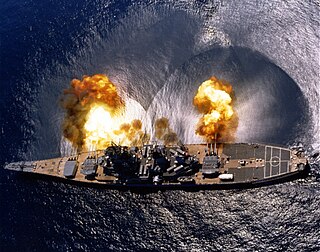
Naval artillery is artillery mounted on a warship, originally used only for naval warfare and then subsequently used for more specialized roles in surface warfare such as naval gunfire support (NGFS) and anti-aircraft warfare (AAW) engagements. The term generally refers to powder-launched projectile-firing weapons and excludes self-propelled projectiles such as torpedoes, rockets, and missiles and those simply dropped overboard such as depth charges and naval mines.

A culverin was initially an ancestor of the hand-held arquebus, but later was used to describe a type of medieval and Renaissance cannon. The term is derived from the antiquated "culuering" and the French "couleuvrine" From its origin as a hand-held weapon it was adapted for use as artillery by the French in the 15th century, and for naval use by the English in the 16th century. The culverin as an artillery piece had a long smoothbore barrel with a relatively long range and flat trajectory, using solid round shot projectiles with high muzzle velocity.
A muzzle-loading rifle is a muzzle-loaded small arm or artillery piece that has a rifled barrel rather than a smoothbore. The term "rifled muzzle loader" typically is used to describe a type of artillery piece, although it is technically accurate for small arms as well. A shoulder arm is typically just called a "rifle", as almost all small arms were rifled by the time breechloading became prevalent. Muzzle and breechloading artillery served together for several decades, making a clear distinction more important. In the case of artillery, the abbreviation "RML" is often prefixed to the guns designation; a Rifled breech loader would be "RBL", or often just "BL", since smoothbore breechloading artillery is almost nonexistent. A muzzle loading weapon is loaded through the muzzle, or front of the barrel. This is the opposite of a breech-loading weapon or rifled breechloader (RBL), which is loaded from the breech-end of the barrel. The rifling grooves cut on the inside of the barrel cause the projectile to spin rapidly in flight, giving it greater stability and hence range and accuracy than smoothbore guns. Hand held rifles were well-developed by the 1740s. A popularly recognizable form of the "muzzleloader" is the Kentucky Rifle, which was actually developed in Pennsylvania. The American Longrifle evolved from the German "Jäger" rifle.
Naval artillery in the Age of Sail encompasses the period of roughly 1571–1862: when large, sail-powered wooden naval warships dominated the high seas, mounting a large variety of types and sizes of cannon as their main armament. By modern standards, these cannon were extremely inefficient, difficult to load, and short ranged. These characteristics, along with the handling and seamanship of the ships that mounted them, defined the environment in which the naval tactics in the Age of Sail developed.

An Armstrong gun was a uniquely designed type of rifled breech-loading field and heavy gun designed by Sir William Armstrong and manufactured in England beginning in 1855 by the Elswick Ordnance Company and the Royal Arsenal at Woolwich. Such guns involved a built-up gun construction system of a wrought-iron tube surrounded by a number of wrought-iron strengthening coils shrunk over the inner tube to keep it under compression.
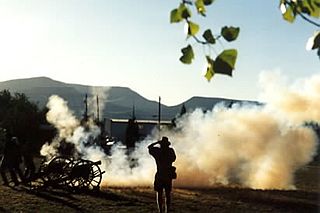
Cannon operation required specialised crew and gunners, who were first enlisted by the Spanish in the 14th century. The nature of cannon operation often depended on the size of the cannon and whether they were breech-loading or muzzle-loading. English cannons of the late 14th century became mobile, while the largest cannon required huge crews to transport and operate them.
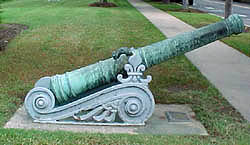
The saker was a medium cannon, slightly smaller than a culverin, developed during the early 16th century and often used by the English. It was named after the saker falcon, a large falconry bird native to the Middle East.

Artillery began to be used in France in the 14th century. The first depiction of a cannon in Europe appeared in Walter de Milemete's 1326 De nobilitatibus, sapientiis, et prudentiis regum. Small rudimentary weapons such as the pot-de-fer or the portable bâton à feu were introduced. At this early stage, cannon would fire either stone balls or metal pellets.

A breech-loading swivel gun was a particular type of swivel gun and a small breech-loading cannon invented in the 14th century. It was equipped with a swivel for easy rotation and was loaded by inserting a mug-shaped device called a chamber or breech block, filled with gunpowder and projectiles. It had a high rate of fire, as several chambers could be prepared in advance and quickly fired in succession and was especially effective in anti-personnel roles. It was used for centuries by many countries of Europe, Asia and Africa.

The 68-pounder cannon was an artillery piece designed and used by the British Armed Forces in the mid-19th century. The cannon was a smoothbore muzzle-loading gun manufactured in several weights, the most common being 95 long cwt (4,800 kg), and fired projectiles of 68 lb (31 kg). Colonel William Dundas designed the 112 cwt version in 1841 and it was cast the following year. The most common variant, weighing 95 cwt, dates from 1846. It entered service with the Royal Artillery and the Royal Navy and saw active service with both arms during the Crimean War. Over 2,000 were made and it gained a reputation as the finest smoothbore cannon ever made.
The Inventory of Henry VIII compiled in 1547 is a list of the possessions of the crown, now in the British Library as Harley MS 1419.
Cetbang were cannons produced and used by the Majapahit Empire (1293–1527) and other kingdoms in the Indonesian archipelago. There are 2 main types of cetbang: the eastern-style cetbang which looks like a Chinese cannon and is loaded from the front, and the western-style cetbang which is shaped like a Turkish and Portuguese cannon, loaded from the back.
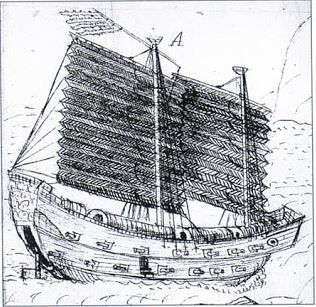
The Ming dynasty continued to improve on gunpowder weapons from the Yuan and Song dynasties as part of its military. During the early Ming period larger and more cannons were used in warfare. In the early 16th century Turkish and Portuguese breech-loading swivel guns and matchlock firearms were incorporated into the Ming arsenal. In the 17th century Dutch culverin were incorporated as well and became known as hongyipao. At the very end of the Ming dynasty, around 1642, Chinese combined European cannon designs with indigenous casting methods to create composite metal cannons that exemplified the best attributes of both iron and bronze cannons. While firearms never completely displaced the bow and arrow, by the end of the 16th century more firearms than bows were being ordered for production by the government, and no crossbows were mentioned at all.

Lela or lila is a type of Malay cannon, used widely in the Nusantara archipelago. They are similar to a lantaka but longer and had larger bore. Lela can be configured as swivel gun, fixed gun, or mounted in a gun carriage. It is the equivalent of European falcon and falconet.




